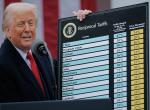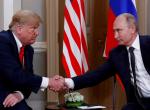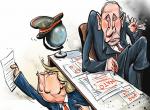The return of Donald Trump to the White House in 2025 has significantly reshaped the global geopolitical landscape, particularly in the ongoing conflict between Russia and Ukraine. His administration's approach to the conflict starkly contrasts with that of his predecessor, Joe Biden, introducing a new and controversial phase in the peace negotiations. With Trump's America First philosophy driving policy decisions, his stance on the war has shifted U.S. priorities from full support for Ukraine’s military efforts to pushing for a swift diplomatic resolution—even if it means Ukraine making concessions.
Trump, being a business-oriented and transactional leader, has long championed the idea of ending the war quickly through direct negotiations with Russian President Vladimir Putin. His proposed peace deal suggests Ukraine adopt a neutral stance and abandon its NATO aspirations—demands that closely align with Russia’s strategic interests. While this approach aims to prevent a prolonged conflict, it raises significant concerns among European allies and Ukraine. There is a genuine concern that the peace talks may potentially allow Moscow to gain undue leverage in negotiations with the US.
The U.S.-Europe Divide
The transatlantic alliance has been tested under Trump’s leadership. While European nations—especially Eastern European countries like Poland and the Baltic states—continue to advocate for Ukraine’s sovereignty and territorial integrity, Trump has openly criticized European nations for their cautious stance. He has argued that Europe should bear more responsibility for supporting Ukraine while suspending U.S. military and financial aid to Ukraine. The United States has supplied USD 66.5 billion in military aid since the Russia-Ukraine war started on February 24, 2022, and around USD 69.2 billion in military assistance since 2014.[1]Countries like France and Germany have sought a balanced diplomatic approach, engaging with Russia while maintaining military and economic support for Ukraine. However, Trump’s pressure for a quick settlement, possibly requiring Ukrainian territorial concessions, has created rifts within the Western alliance.
Europe’s Independent Diplomacy
While the U.S. plays a key role in the negotiations, European nations have pursued their own diplomatic efforts to support Ukraine. Ukrainian President Volodymyr Zelenskyy has consistently rejected any peace deal involving territorial concessions, particularly regarding Crimea and the Donbas region. While European leaders back Ukraine’s position, they also recognize the need for a ceasefire and de-escalation to ensure long-term stability in the region. Eastern European nations remain the most vocal in their opposition to any compromise with Russia, fearing that such concessions would embolden Putin and pose a direct threat to their security. The divergence between Trump's stance and Europe’s commitment to Ukraine could result in a fragmented Western response to the conflict.
The UK Prime Minister Keir Starmer has reiterated Britain’s commitment to providing military aid and reinforcing sanctions against Russia. The UK has also played a significant role in ensuring European unity on Ukraine policy, working closely with NATO allies and the European Union.
In March 2025, Starmer met with Ukrainian President Volodymyr Zelensky to discuss the ongoing negotiations and reaffirm the UK’s position. The meeting focussed on military assistance, economic aid, and potential post-war security guarantees for Ukraine. Starmer has emphasized that any peace settlement must uphold Ukraine’s sovereignty and that the UK will continue to oppose any deal that forces territorial concessions from Kyiv.
Due to varying perspectives in Europe on peace talks related to Ukraine, the UK Prime Minister and French President Emmanuel Macron have launched an initiative called the 'Coalition of the Willing' to strengthen support for Ukraine in its conflict with Russia. The coalition recently held its third meeting in Paris, gathering around 30 leaders to discuss Ukraine's ongoing security situation. This comes after a ceasefire agreement was negotiated by the US between Moscow and Kyiv concerning the Black Sea earlier this week, although the Kremlin has stated that the ceasefire cannot take effect unless specific conditions are fulfilled (especially the lifting of sanctions on Russia). [2]
The U.S.-Russia Peace Talks in Riyadh
On March 24, 2025, U.S. and Russian officials engaged in a marathon 12-hour negotiation session in Riyadh, Saudi Arabia, discussing a proposed 30-day truce. While no formal agreement was signed, a draft statement was reportedly submitted to Washington and Moscow for approval. Trump is aiming to finalize a Contract for Peace by mid-April 2025. Additional meetings have taken place, including a follow-up session on March 25, where U.S. officials engaged with Ukrainian representatives to ensure Kyiv remains informed about the negotiation process.
The meeting focussed on several key topics. First, there was a discussion about implementing a temporary 30-day ceasefire, primarily aimed at halting attacks on energy infrastructure. Additionally, the establishment of a maritime truce was proposed to create a secure corridor in the Black Sea, which would allow for the resumption of commodity exports and ensure safe navigation. Security guarantees were another point of discussion, with Russia seeking assurances regarding Ukraine’s NATO aspirations and its military positioning. Furthermore, Moscow raised concerns about Western sanctions, requesting gradual economic relief in exchange for de-escalation. Lastly, there were talks about freezing territorial positions to facilitate further negotiations.
Although no official deal was signed, a draft proposal was prepared and sent to Moscow and Washington for further review. Russian officials indicated conditional support for the proposed ceasefire but emphasized their firm stance on territorial claims. The U.S. delegation expressed cautious optimism while underscoring the importance of respecting Ukraine's sovereignty. Despite the discussions, military activities continued, with Russian airstrikes and Ukrainian counteroffensives highlighting the fragile nature of the ongoing negotiations.
Prior to the Riyadh meetings, a U.S.-Ukraine agreement was reached in Jeddah on March 11, where Ukraine accepted a temporary 30-day ceasefire proposal that could be extended by mutual consent. Russia, while agreeing in principle to an energy truce, has maintained its stance against a full ceasefire unless Ukraine commits to neutrality and recognizes Russia's territorial claims.
Putin's government has pushed for the lifting of sanctions, while Trump’s team has explored potential compromises, such as freezing the front lines and creating a demilitarized zone. However, the trust deficit remains high, as ongoing Russian strikes and Ukrainian counteroffensives continue to undermine diplomatic progress.
As of now, the negotiations remain fluid, with Trump aiming for a swift resolution while European allies and Ukraine proceed with caution. The final outcome of these talks could significantly reshape the geopolitical balance in Eastern Europe and influence the broader stability of the international order.
Russia’s Position and Response
From Moscow’s perspective, Trump’s return to power presents an opportunity to secure favourable terms. Putin has historically preferred dealing with Trump, who has shown skepticism toward NATO and a willingness to reassess U.S. commitments to European security. Russia has indicated conditional support for ceasefire agreements but remains firm in its demands—Ukraine’s neutrality and recognition of Russian control over annexed regions. The possibility of U.S. sanctions relief under a Trump-negotiated peace deal is another key factor. With Russia’s economy heavily impacted by Western sanctions, lifting these restrictions would provide a significant boost to Moscow’s economic and military capabilities.
Challenges and Future Prospects
Despite Trump's confidence in securing a peace deal, several key challenges remain. Firstly, Ukraine’s stance is a significant hurdle, as Zelenskyy’s administration has made it clear that they refuse to compromise on territorial integrity. This rigidity complicates Trump's ability to negotiate a deal that satisfies both U.S. and Russian objectives. Additionally, there is strong European opposition to any agreement that might favour Russia, as such a deal could fracture the Western alliance and undermine Ukraine’s sovereignty. Concerns are also arising regarding NATO's future role in European security, especially given Trump’s skepticism toward the alliance. This has led to worries about the implications if the U.S. were to reduce its commitments. Finally, the domestic political dynamics in the United States add another layer of complexity to Trump's approach to Russia, which remains a subject of controversy. He faces resistance not only from Democrats but also from some Republicans who advocate for continued support for Ukraine.
Although a limited ceasefire has been agreed upon regarding energy infrastructure, maritime access, and the easing of sanctions on Russia, there is no certainty regarding its duration. The fighting is still ongoing, and Moscow, in order to gain an upper hand, will likely increase its offensive actions. On the other hand, Zelenskyy's adamant position of not involving Putin and the uncertain dynamics with the US pose another disadvantage for the entire peace process.
Conclusion: A Precarious Peace?
Trump’s efforts to broker a resolution to the Russia-Ukraine conflict mark a pivotal moment in international diplomacy. While his approach could lead to a ceasefire and a de-escalation of hostilities, the broader implications of such a deal remain uncertain. If negotiations result in territorial concessions to Russia, it could set a precedent for future conflicts and weaken global deterrence against aggressive expansionism. Ultimately, Trump’s handling of the Russia-Ukraine war will shape not only the future of Ukraine but also the stability of the broader international order. Whether his strategy leads to lasting peace or further geopolitical instability remains to be seen.
References
[1] Fact Sheet, U.S. Security Cooperation with Ukraine, Bureau of Political-Military Affairs, US Department of State. March 12, 2025. https://www.state.gov/bureau-of-political-military-affairs/releases/2025/01/u-s-security-cooperation-with-ukraine#
[2] Rachel Clun, ‘Who is in Starmer’s Coalition of the Willing? European leaders meet to discuss Ukraine-Russia war’ The Independent, 28 March 2025. https://www.independent.co.uk/news/world/europe/starmer-ukraine-coalition-of-the-willing-countries-b2723117.html
(The paper is the author’s individual scholastic articulation. The author certifies that the article/paper is original in content, unpublished and it has not been submitted for publication/web upload elsewhere, and that the facts and figures quoted are duly referenced, as needed, and are believed to be correct). (The paper does not necessarily represent the organisational stance... More >>
Image Source: https://www.reuters.com/resizer/v2/2AGEWLMCD5MUBPR4OOIVRABTJU.jpg?auth=ce89dd06e7e7f475c8160f073d076e1a1563e9864917c5997896232e82c9024b&width=1628&quality=80










Post new comment